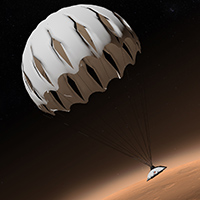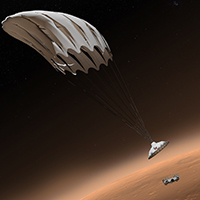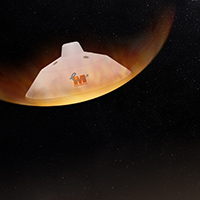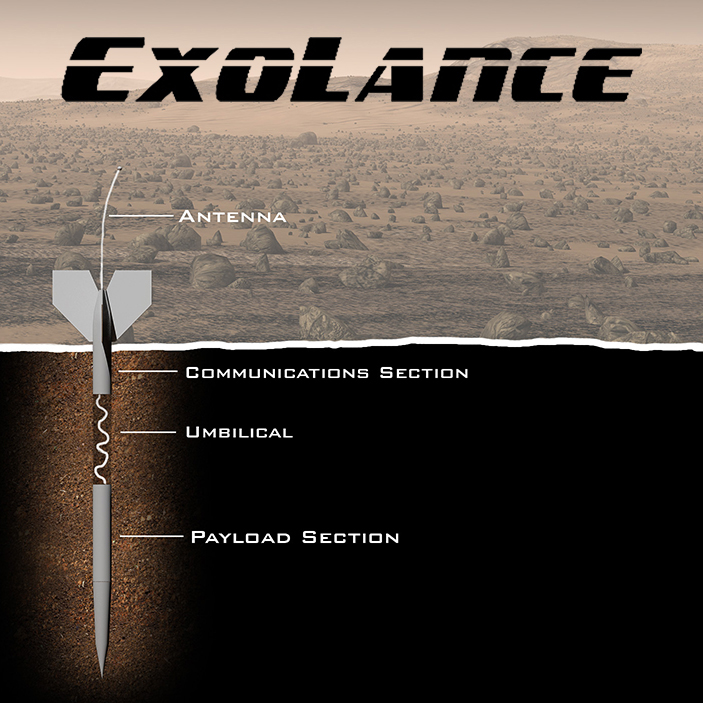- About Us
- Columns
- Letters
- Cartoons
- The Udder Limits
- Archives
- Ezy Reading Archive
- 2024 Cud Archives
- 2023 Cud Archives
- 2022 Cud Archives
- 2021 Cud Archives
- 2020 Cud Archives
- 2015-2019
- 2010-2014
- 2004-2009
 |
Ezy Reading: |
Humans have been fascinated with the search for life on other planets –and, in particular, Mars– for generations. Over the past decade, NASA’s Exploration Rover Mission has been especially successful in capturing the interest of a wide public audience, ever intrigued with learning of new discoveries and viewing images from the Red Planet. Funding for missions to Mars (and space exploration in general) is, of course, an ongoing struggle, particularly for those scientists looking to implement more innovative approaches. Recently The Cud’s Evan Kanarakis had a chance to sit down with two such innovators dedicated to taking the Mars search further through the aptly named organization ‘Explore Mars’– Chris Carberry (Executive Director, Explore Mars Inc.) and Joe Cassady (Executive Director for Space, Aerojet Rocketdyne Washington Operations).
THE CUD: Tell us about the Explore Mars initiative.
CHRIS CARBERRY: Put simply, Explore Mars is a US-based non-profit founded in 2010 with the goal of sending humans to Mars within the next two decades. To further that goal, we conduct programs and technical challenges to stimulate the development and/or improvement of technologies that will make human Mars missions more efficient and feasible.
THE CUD: The exploration of Mars has captured the public’s imagination for the longest time. How can you really entrench the importance and viability of sending humans to Mars beyond the stuff of mere science fiction?
CHRIS: Part of our mission with Explore Mars is to challenge educators to use Mars in the classroom as a tool to teach standard STEM [science, technology, engineering, mathematics] curricula. We run the Humans to Mars Summit, the Affording Mars Initiative, the Teaching Mars workshops, the Time Capsule to Mars project, Exolance, and many other projects. Some of our advisors include Buzz Aldrin, Miles O'Brien (PBS), Andrew Chaikin, and Chris McKay (NASA).
 THE CUD: For those who aren't in the know, why Mars? Why search for life on this planet over others within our solar system- or among other potential subjects for exploration and research (e.g. comets, part of the recent Rosetta mission)?
THE CUD: For those who aren't in the know, why Mars? Why search for life on this planet over others within our solar system- or among other potential subjects for exploration and research (e.g. comets, part of the recent Rosetta mission)?
CHRIS: Mars is one of the most likely planetary bodies in the solar system to be able to sustain life. There are other potential locations, but Mars is by far the closest of these choices and the only planet that humans could explore in the foreseeable future.
THE CUD: How so?
CHRIS: Mars is the gateway. All future deep space missions will likely use Mars as a waypoint or launching stage for exploring anything farther in our solar system. There’s also a growing body of evidence established by other missions that Mars once likely had an atmosphere and other necessary components to support life, methane, liquid water. While there are many other compelling missions, no other destinations have so many compelling reasons to explore - and no other destination has as much public support.
THE CUD: This brings us to Exolance. Tell us about the mission. How does it differ from previous explorations and approaches to discovering life on Mars?
CHRIS: Current NASA missions (and planned missions) are only looking for evidence of past life - not current life. That’s why we started ExoLance - to prove out a system to look for current life on Mars. Most experts believe that if life exists on Mars, it will be below the surface. Exolance will penetrate 1-3 meters below the surface to reach a depth that could feasibly shield life from radiation. We are proposing to send up to six ExoLance penetrators to Mars along with a landing mission so we can test in numerous locations.
THE CUD: Share with us a little of the science behind this proposed mission- it sounds like one part geology, another part biology...
JOE CASSADY: ExoLance is really about getting the science down under the surface of Mars. Initially we conceived it with some of our scientist colleagues who want to search for life on Mars because they’re convinced that the best place to look is below the surface… But other types of science payloads are also interested in ExoLance because we can get them more opportunities to fly their instruments and can place them in diverse locations. So, while the search for life is the driving force behind the development of ExoLance, we also see a future full of other uses – possibly some even here on Earth.
THE CUD: If we can't be sure of what forms of life may or may not exist on Mars, is an approach that could, by its nature, extinguish life not a little risky? On the face of it, 'firing missiles into the surface of Mars to try and find life' sounds a little counter-intuitive, no? Couldn't that run the risk of destroying life?
JOE: Astrobiologists are pretty sure that life under the surface of Mars, if it exists, is going to be microbial. So we are not talking little green men, but something like bacteria on Earth. When we tunnel down using the penetrator, there is a narrow “affected zone”– but just a few centimeters beyond that, the Mars dirt will be pristine. That’s where we will sample to look for the little critters. As to why do it this way, as opposed to a drill, the answer is simple. It’s lighter and cheaper… And by the way, a drill will also have an affected zone. You can’t avoid disturbing some of the dirt if you want to get down there.
That’s where we will sample to look for the little critters. As to why do it this way, as opposed to a drill, the answer is simple. It’s lighter and cheaper… And by the way, a drill will also have an affected zone. You can’t avoid disturbing some of the dirt if you want to get down there.
THE CUD: What kind of time frame would this approach need from testing through to touching down on Mars?
JOE: Phase 1, which is what we are seeking crowdfunding for, builds and tests the prototype penetrator design. That phase will take approximately 12 months after we kick it off.
THE CUD: And after that?
JOE: After that, we’ll publish specifications for the science payloads and see what scientists are interested. Development of the science instruments will probably take about 1 – 2 years. We’ll also start developing the rest of the ExoLance probe, the power system, the radio, etc…
THE CUD: So to have a flight ready probe, what are we talking…
JOE: We should be able to field a flight ready ExoLance in 3 – 5 years from right now. The rest of the story is how we get to Mars and there we’re at the mercy of other people’s missions. The good news is that there are many planned missions and we would ideally reach out to work with all parties (NASA, ESA, etc.) to see if we can hitch a ride. That’s likely to be sometime in the early 2020’s.
THE CUD: Why turn to Indiegogo to raise funds for the project? Much of your team is comprised of former and current NASA scientists, so what does this tell us about the current (and dire?) state of science funding in this country at the moment that you're forced to turn to crowdfunding for such an important mission?
JOE: Sometimes “out of the box” ideas need a little help to get them considered. That is really what we’re turning to the public for. When we announced ExoLance it received an enthusiastic response from scientists. But space agency budgets are tight, and we have some things to prove out to convince the serious mission planners that ExoLance isn’t just ‘a neat idea’. That’s where the public can help. If we can get through Phase 1 and show the penetrator works and that the science instruments won’t be smashed up in the process, we can take that data forward to get ExoLance considered for project funding.
THE CUD: What are your thoughts on the odds of finding life here?
JOE: Given the increasing evidence of the large amount of water on Mars (again under the surface) and the clear evidence here on Earth that life finds ways to thrive in the presence of water, it seems probable that Mars should offer a similar good environment somewhere beneath its surface where the radiation and oxidizing effects are reduced. So better than 50:50, how’s that?
Given the increasing evidence of the large amount of water on Mars (again under the surface) and the clear evidence here on Earth that life finds ways to thrive in the presence of water, it seems probable that Mars should offer a similar good environment somewhere beneath its surface where the radiation and oxidizing effects are reduced. So better than 50:50, how’s that?
THE CUD: Should the mission follow through and find no life on Mars- would you consider that a failure, or just part of an important 'checklist' of sorts in our ongoing exploration of the space we live in?
JOE: If we don’t find life at first, we should keep looking. Mars is a big planet and we’ve only scratched the surface (literally) so even if the first batch of ExoLances don’t produce compelling evidence for life, we should send another batch to a different region of Mars.
THE CUD: Lastly, were money and technology no object, where would you focus all of our exploring?
JOE: It’s still Mars. Ultimately, if money and technology were not constrained, we need to send humans to Mars to continue the search as only human explorers can.
Media Quick Links:
Indiegogo Project ExoLance: www.indiegogo.com/projects/exolance
ExoLance Website: www.exolance.exploremars.org/
Explore Mars Website: www.exploremars.org/
Twitter: @ExploreMars @ExoLanceMars
Facebook: www.facebook.com/exploremarsdotorg
Reddit: www.reddit.com/user/ExploreMarsOrg/
YouTube: www.youtube.com/channel/UCCtmqmqmf0ORtfP52WydTrg
Ezy Reading is out every month.
